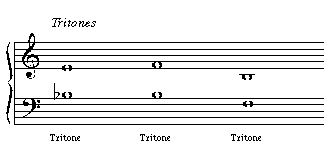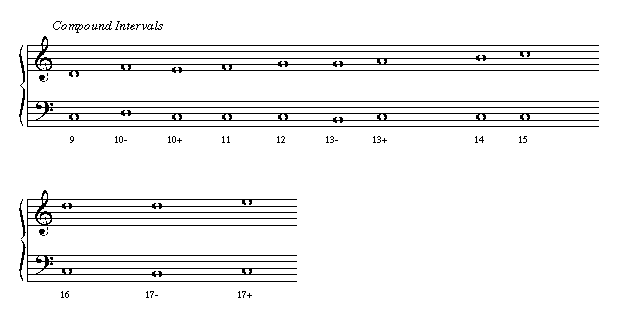
When one note sounds against another that sound is perceived by our ear as either just and harmonious or harsh and dissonant according to the ratio of the tones. These ratios may be determined by examining the length of the string required to produce each tone upon a monochord. If the ratio of the lengths forms a harmonious interval, the sound will be pleasant, but if the ratio of the lengths forms a dissonant interval, the sound will be unpleasant.
Thus we may divide the genus of interval into the species of consonant---comprising those intervals which have a pleasant and harmonious sound---and dissonant comprising those intervals which have a harsh and unpleasant sound. We may also divide the consonant intervals into perfect consonances, which sound almost as one note to our ear, and imperfect consonances which merely sound pleasant together. The rules of counterpoint regulate when one may place a consonance and when one may place a dissonance. Thus knowing the species of intervals is essential for learning counterpoint.
The first perfect consonance is the unison which is made by two strings of equal length. Thus, if two singers both sing the same note, such as C fa ut, they will sound in unison. As the unison makes one in the same sound, it must be used with care or else the ear may hear fewer voices than there are in the counterpoint.

The second perfect consonance is the diapason or octave which is made by two strings one of which is twice the length of the other. Thus, its ratio is the duple. If one singer sings C fa ut and the other sings c fa sol ut they will sound a diapason. It is also called an octave because there are eight notes ( C D E F G a b c) in its compass. The double octave is sounded if one string is four times the length of the other. In the diapason the two sounds are very similar (as if the same note was sang by a boy and by a man), and are treated as if they were almost the same, thus the diapason must also be used with care.

The third perfect consonance is the diapente or fifth. This consonance is made by two strings one of length 2 and one of length 3. Thus, its ratio is the sesquialter. It is the harmonic mean of the diapason as it falls in the proportion 4:3:2, where 4:2 is a duple and represents the octave. It is made when one singer sings a ut and the other a sol in the same hexachord, as in a C fa ut against a G sol ut. It is also called the fifth because its span encompasses five notes ( C D E F G); in a true diapente there will always be three whole tone steps and a semitone step ( E F or B C). The diapason plus diapente or twelfth is like the diapente in most all respects and is treated the same way. The two notes of the diapente have much in the way of similar qualities and thus the diapente must be used with care lest the two voices be heard as one.

Note that when a diapente divides a diapason, the remaining interval is a diatessaron or fourth. The ratio of this interval is the sesquitertia, 4:3, and thus it is made by two strings one of length 3 and one of length 4. It spans two whole tones and a semitone. Among the ancients, such as B\oe thius, it was considered a perfect consonance and it is still classified thus in the books on the theory. However, practicing musicians (in particular, Tinctoris) call the fourth a dissonance. The reason is thus: F fa ut sung against a b-molle fa [b-flat] is a true diatessaron while a F fa ut sung against a b-duram mi [b-natural] is not a diatessaron but that most harsh and diabolic of intervals, the tritone. Thus practical musicians treat the fourth as a dissonance wherever this is found. This is also true for the diapason plus diatessaron or eleventh and similar intervals.
The imperfect consonances are two in number: the third and the sixth. Each of these has a major species which is harsher and more joyful and a minor species which is sweeter and sadder.
The minor third or semiditone is made up of a whole tone and a semitone, hence its ratio is 32:27. Zarlino says that a true semiditone should be tempered so that it obtains the interval of 6:5 (and hence sounds more sweetly), but this must be done with care, or else the other tones of the gamut will go awry. One can hear the minor third when two singers sing re against fa or mi against sol as in A re against C fa ut or E la mi against G sol re ut or similar notes. The minor tenth or semiditone plus diapason sounds similar in almost all respects to the minor third.
The major third or ditone is made up of two whole tones, hence its ratio is 81:64. Zarlino says that a true ditone should be tempered so that it obtains the interval of 5:4 (and hence sound more sweetly), but again this must be done with care. Thus tempered the ditone and semiditone divide the diapente in the ratio 6:5:4, much as the diapente and diatessaron divide the diapason. One can hear the major third when two singers sing ut against mi or fa against la as in C fa ut against E la mi or similar notes. The major tenth or ditone plus diapason sounds similar in almost all respects to the major third.

The minor sixth is a composite interval made up of a diapente and a semitone. One can hear the minor sixth when two sing E la mi against c sol fa ut or similar notes. The minor thirteenth sounds similar in almost all respects to the minor sixth.
The major sixth is a composite interval made up of a diapente and a whole tone. One can hear the major sixth when one sings C fa ut against a la mi re or similar notes. The major thirteenth sounds similar in almost all respects to the major sixth.

There are six species of dissonances: the semitone or minor second, the tone or major second, the minor seventh or diapente plus semiditone, the major seventh diapente plus ditone, the false intervals (the tritone, the diminished diapente and the false octave) , and finally the diatessaron or perfect fourth which is according to the theorists a consonance but according to practice plays the role of a dissonance.
The whole tone or major second is the basic interval from which the notes of the gamut are created. It has the ratio of 9/8, although some would temper it slightly to make other notes sweeter. The whole tone occurs between each pair of adjacent notes in the hexachord except between mi and fa. Thus if two were to sing C fa ut against D sol re, or D sol re against E la mi, or F fa ut against G sol re or G sol re against a la mi re, the sound would be a whole tone. The sound of the whole tone is harsh, but it can be borne for a short while as a contrast to other, sweeter harmonies. The major ninth sounds similar to the major second and plays the same role in counterpoint.
The semitone or minor second is a subdivision of the whole tone. It occurs in naturally between mi and fa of the hexachord, for example between E la mi and F fa ut, between a la mi re and b-molle fa [b-flat] and between b-duram mi and c sol fa ut. It has the ratio 256:243, and its sound is very harsh. The minor ninth sounds similar to the minor second and plays the same role in counterpoint.

The minor seventh is a composite interval made up of a diapente and a semiditone. One can hear the minor sixth when one sings D sol re against c sol fa ut or similar notes. The minor seventh spans four whole tones and two semitones. The minor fourteenth sounds similar in almost all respects to the minor seventh.
The major seventh is a composite interval made up of a diapente and a ditone. One can hear the major sixth when one sings C fa ut against b-duram mi or similar notes. Its sound is again very harsh. It spans five whole tones and two semitones. The major fourteenth sounds similar in almost all respects to the major seventh.

There are a large number of intervals whose sound is so harsh and horrible that they are hardly premitted in music at all. Among these false intervals, the tritone has already been mentioned as a possible reason why the fourth is not reguarded as a consonance. The tritone has the ratio 729/512 and spans three whole tones (hence the name). It is made when one singer sings mi and the other a fa of a different hexachord, for example between F fa ut and b-duram mi and between b-molle fa and e la mi. In this case, often one of the singers will apply musica ficta to one of the notes, lowering it by a semitone, to sing a sweeter interval (a diatessaron). Thus the singer will sing b-molle fa against F fa ut when what is written is b-duram mi, or else the singer will lower the e la mi by a semitone when it sounds against b-molle fa.
Another false interval is the diminished diapente found between b-duram mi and f fa ut comprising two whole tones and two semitones. Similarly the false octave between B-duram and b-molle and the false unison between b-duram and b-molle are false intervals. These intervals should be avoided, even to the point of applying musica ficta to avoid their harshness. Similarly, one should be careful when adding chromatic tones to the music not to inadvertently create these intervals.

Finally, we note once more that the fourth or diatessaron is considered a dissonance in practice. There are a number of possible reasons for this: (1) If one uses fourths too freely one may carelessly place a tritone in a place where a consonance is called for. (2) If one tempers an organ so that the thirds sound sweetly, the fourths may sound much more harshly. (3) In the diapente, the upper voice takes on much of the qualities of the bass, amplifying in and filling it. In the diatessaron, the bass takes on the qualities of the upper voice, thus transforming its nature; this transformation must not be used carelessly.

It is possible to produce compound intervals by adding an octave or double octave to any of the intervals discussed above. In each case the compound interval plays the same role as its prototype. Thus, major thirds and major tenths are treated the same according to the rules of counterpoints, as are fifths and twelfths, fourths and elevenths, and unisons and octaves.

Onward to: Chapter 8: The Rules of Counterpoint.
[Previous Chapter][Next Chapter]
[Paper Table of Contents]
[References]
[Basse Dance Project Homepage]
[Russell Almond's Dance Music Page]
This file developed and maintained by
Russell G. Almond